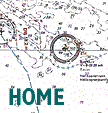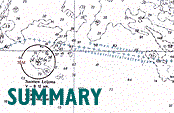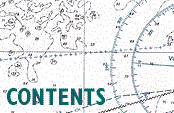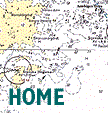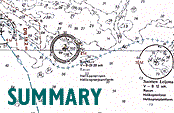 |
A number of incidents involving failure or part-failure of bow visor attachment devices have occurred in the Baltic Sea and the North Sea during the history of the ro-ro ferries. The ships involved have all been under the survey of one of four major classification societies. The following list of some of these incidents includes two involving vessels equipped with clam doors. It is especially noted that many of the incidents occurred during the first year of the vessel's operation.
 With two exceptions, the list contains only Swedish and Finnish vessels and is not complete. It may be concluded that similar incidents have occurred in other areas of the world. It is, however, worth noting that the extensive flare in the bow profile of the vessels has in several instances been blamed as a contributing factor. Ferries built for Baltic Sea operators had at the time a more pronounced bow flare profile than ferries built for other services. With two exceptions, the list contains only Swedish and Finnish vessels and is not complete. It may be concluded that similar incidents have occurred in other areas of the world. It is, however, worth noting that the extensive flare in the bow profile of the vessels has in several instances been blamed as a contributing factor. Ferries built for Baltic Sea operators had at the time a more pronounced bow flare profile than ferries built for other services.
 After the ESTONIA accident administrations and classification societies performed extensive surveys of the condition of locking devices and hinges on all ro-ro ferries within their territory. The results showed a rather high frequency of defects of varying degrees of severity, needing corrective work. One of the classification societies reported that some kind of defect, e.g. cracks or deformation of locking devices, was found in about 30 per cent of the ferries inspected. Most of the defects were, however, relatively small. After the ESTONIA accident administrations and classification societies performed extensive surveys of the condition of locking devices and hinges on all ro-ro ferries within their territory. The results showed a rather high frequency of defects of varying degrees of severity, needing corrective work. One of the classification societies reported that some kind of defect, e.g. cracks or deformation of locking devices, was found in about 30 per cent of the ferries inspected. Most of the defects were, however, relatively small.
|
 |
 |
VISBY, a passenger ferry built in 1972 - whilst proceeding from Nynäshamn to Visby in December 1973 - hit a couple of heavy waves which caused the visor to open. The ship was turned and returned safely to Nynäshamn. It was concluded that the locking devices were too weak, and heavier devices were installed. The matter was dealt with in correspondence between the Swedish Maritime Administration and the classification society involved and information was received that the society had substantially increased the strength requirements. The effect of extensive flare in the bow contour was also discussed.
 STENA SAILER, a cargo ferry built in 1973, experienced heavy weather and head sea in January 1974. Speed was reduced but the visor locking devices failed. The ramp remained intact and the ship turned and headed for shelter. It was noted in the investigation that a similar incident had happened earlier and that a sister vessel under another flag had also had a similar incident. STENA SAILER, a cargo ferry built in 1973, experienced heavy weather and head sea in January 1974. Speed was reduced but the visor locking devices failed. The ramp remained intact and the ship turned and headed for shelter. It was noted in the investigation that a similar incident had happened earlier and that a sister vessel under another flag had also had a similar incident.
 An administration report concluded inter alia that “nearly all locking devices of bow doors on existing vessels are too weak” and recommended that the administration should first investigate how such should be designed and built, and thereafter inspect existing vessels (see 15.13). An administration report concluded inter alia that “nearly all locking devices of bow doors on existing vessels are too weak” and recommended that the administration should first investigate how such should be designed and built, and thereafter inspect existing vessels (see 15.13).
 SVEA STAR, a passenger ferry built in 1968, experienced heavy weather in May 1974. A heavy wave lifted the visor. Water collected in the visor but the ramp remained closed. The ship turned and regained port. SVEA STAR, a passenger ferry built in 1968, experienced heavy weather in May 1974. A heavy wave lifted the visor. Water collected in the visor but the ramp remained closed. The ship turned and regained port.
 WELLAMO, a passenger ferry built in 1975, encountered a south-westerly storm on a scheduled voyage from Helsinki to Stockholm on a December night in 1975. About 10 nautical miles south of the Bengtskär lighthouse the officer of the watch noted that the bow visor lifted. He woke up the master. The visor was illuminated with an Aldis lamp and about five minutes later the visor lifted again. Speed was immediately reduced from about eight knots to three knots. The master and the chief engineer inspected the visor and due to the damage and the storm the master decided to turn back to Helsinki. WELLAMO, a passenger ferry built in 1975, encountered a south-westerly storm on a scheduled voyage from Helsinki to Stockholm on a December night in 1975. About 10 nautical miles south of the Bengtskär lighthouse the officer of the watch noted that the bow visor lifted. He woke up the master. The visor was illuminated with an Aldis lamp and about five minutes later the visor lifted again. Speed was immediately reduced from about eight knots to three knots. The master and the chief engineer inspected the visor and due to the damage and the storm the master decided to turn back to Helsinki.
 Next morning in Helsinki it was observed that the locking cleats were torn away and the arms of the visor were partly broken. Side plating on both sides of the visor was dented, as was a light bulkhead inside the visor. There was a small hole on the tanktop, caused by pounding of the visor. The local structure at the locking devices was reinforced, the arms were repaired and reinforced, side plating was renewed and the bow visor hull was repaired on both sides. The bulkhead was reinforced with stiffeners. Two sister vessels were similarly reinforced. Next morning in Helsinki it was observed that the locking cleats were torn away and the arms of the visor were partly broken. Side plating on both sides of the visor was dented, as was a light bulkhead inside the visor. There was a small hole on the tanktop, caused by pounding of the visor. The local structure at the locking devices was reinforced, the arms were repaired and reinforced, side plating was renewed and the bow visor hull was repaired on both sides. The bulkhead was reinforced with stiffeners. Two sister vessels were similarly reinforced.
 FINLANDIA, a passenger ferry built in 1981 on a scheduled voyage from Helsinki to Stockholm in the autumn of 1981 encountered heavy south-westerly seas south of Hanko. Next morning in Stockholm, the visor did not open and severe damage was found including dented structure on the port side and two broken locking bars on the centre line. FINLANDIA, a passenger ferry built in 1981 on a scheduled voyage from Helsinki to Stockholm in the autumn of 1981 encountered heavy south-westerly seas south of Hanko. Next morning in Stockholm, the visor did not open and severe damage was found including dented structure on the port side and two broken locking bars on the centre line.
 The visor had lifted a few centimetres and moved to starboard. Thus, additional locating horns were fitted on both sides and the structure on the back was reinforced. Locking devices were also reinforced. A sister vessel was similarly reinforced. The visor had lifted a few centimetres and moved to starboard. Thus, additional locating horns were fitted on both sides and the structure on the back was reinforced. Locking devices were also reinforced. A sister vessel was similarly reinforced.
 SAGA STAR, a cargo and passenger ferry built in 1981, was about to depart from port in May 1982. When the visor was being lowered the port side hinge failed, resulting in failure also of the starboard side hinge, and the visor fell down. The ship was allowed to sail a couple of voyages without visor until repairs had been performed. SAGA STAR, a cargo and passenger ferry built in 1981, was about to depart from port in May 1982. When the visor was being lowered the port side hinge failed, resulting in failure also of the starboard side hinge, and the visor fell down. The ship was allowed to sail a couple of voyages without visor until repairs had been performed.
 VIKING SAGA, a passenger ferry built in 1980, was extensively damaged on the fore part and on the lower port side of the bow visor south of Hanko in October 1984, on a scheduled voyage from Helsinki to Stockholm. The incident took place when the vessel was running at 16 knots in heavy bow seas with a wind speed of about 14 m/s. Next morning in Stockholm it was observed that a large part of the port visor shell construction together with a horizontal platform had been dented. A locating horn on the port side was bent towards the centre line and side lockings were damaged. Several stiffeners, beams, large areas of shell plating and part of the platform were renewed. The visor construction was not reinforced, since the incident was considered typical heavy weather damage. VIKING SAGA, a passenger ferry built in 1980, was extensively damaged on the fore part and on the lower port side of the bow visor south of Hanko in October 1984, on a scheduled voyage from Helsinki to Stockholm. The incident took place when the vessel was running at 16 knots in heavy bow seas with a wind speed of about 14 m/s. Next morning in Stockholm it was observed that a large part of the port visor shell construction together with a horizontal platform had been dented. A locating horn on the port side was bent towards the centre line and side lockings were damaged. Several stiffeners, beams, large areas of shell plating and part of the platform were renewed. The visor construction was not reinforced, since the incident was considered typical heavy weather damage.
 STENA JUTLANDICA, a passenger ferry built in 1983, experienced in October 1984 failure of the visor hinges during normal opening. The main reason for failure of the hinges was cracks in the welds. The hinges were reinforced, also on a sister vessel. STENA JUTLANDICA, a passenger ferry built in 1983, experienced in October 1984 failure of the visor hinges during normal opening. The main reason for failure of the hinges was cracks in the welds. The hinges were reinforced, also on a sister vessel.
 ILYICH, a passenger ferry built in 1973, encountered heavy seas with a wind speed of about 18 m/s on a scheduled voyage from Leningrad to Stockholm in December 1984. At a speed of about 17 knots, one of the visor deck hinges failed fully, the other partly and all visor locking devices broke. The visor hung on the hinge and moved up, down and sideways every time the seas lifted the visor. The incident was quickly observed from the bridge, speed was significantly reduced and the vessel run to more sheltered waters. The vessel was also involved in an incident in September 1986 at a speed of about seven knots. In this case, three visor locking bolts broke and other damage occurred. The structure of the bow visor and hinges was reinforced, locking devices were replaced by significantly stronger ones and side locating horns were fitted in 1989. ILYICH, a passenger ferry built in 1973, encountered heavy seas with a wind speed of about 18 m/s on a scheduled voyage from Leningrad to Stockholm in December 1984. At a speed of about 17 knots, one of the visor deck hinges failed fully, the other partly and all visor locking devices broke. The visor hung on the hinge and moved up, down and sideways every time the seas lifted the visor. The incident was quickly observed from the bridge, speed was significantly reduced and the vessel run to more sheltered waters. The vessel was also involved in an incident in September 1986 at a speed of about seven knots. In this case, three visor locking bolts broke and other damage occurred. The structure of the bow visor and hinges was reinforced, locking devices were replaced by significantly stronger ones and side locating horns were fitted in 1989.
 MARIELLA, a passenger ferry built in 1985, experienced heavy seas on a scheduled voyage from Helsinki to Stockholm in November 1985. The starboard hinge brackets sheared. Both starboard and port hinge beams were almost fully cut. Locking devices and the hydraulic actuators failed and the visor was forced open. Indications of brittle fracture were subsequently noted in shorn-off locking bars. The incident occurred at about 13 knots. Speed was significantly reduced when the incident was visually observed from the bridge, whilst the vessel continued her voyage in more sheltered waters. MARIELLA, a passenger ferry built in 1985, experienced heavy seas on a scheduled voyage from Helsinki to Stockholm in November 1985. The starboard hinge brackets sheared. Both starboard and port hinge beams were almost fully cut. Locking devices and the hydraulic actuators failed and the visor was forced open. Indications of brittle fracture were subsequently noted in shorn-off locking bars. The incident occurred at about 13 knots. Speed was significantly reduced when the incident was visually observed from the bridge, whilst the vessel continued her voyage in more sheltered waters.
 The visor was temporarily repaired immediately after the incident. Permanent repairs, including heavy reinforcements of the locking devices and appropriate structures, were carried out later. Reinforcements were made for instance at the lower locks of the visor and below the upper locking devices. Additional locating horns were fitted on each side and the structure on the backs of these was reinforced with stiffeners. A sister vessel was similary reinforced. The visor was temporarily repaired immediately after the incident. Permanent repairs, including heavy reinforcements of the locking devices and appropriate structures, were carried out later. Reinforcements were made for instance at the lower locks of the visor and below the upper locking devices. Additional locating horns were fitted on each side and the structure on the backs of these was reinforced with stiffeners. A sister vessel was similary reinforced.
 TOR HOLLANDIA, a passenger ferry built in 1973, in heavy weather during the winter of 1986/87, experienced failure of the visor bottom attachments and one deck hinge. The condition was observed visually from the bridge and rapid evasive action prevented an accident. Extensive reinforcements were made in conjunction with the repair. TOR HOLLANDIA, a passenger ferry built in 1973, in heavy weather during the winter of 1986/87, experienced failure of the visor bottom attachments and one deck hinge. The condition was observed visually from the bridge and rapid evasive action prevented an accident. Extensive reinforcements were made in conjunction with the repair.
 FINNHANSA, a passenger ferry built in 1966, lost her clam doors in January 1977 in heavy weather close to the Helsinki lighthouse. The doors were not properly secured. When it was noted that the clam doors were about 0.5 m open, the vessel was stopped in order to get the doors closed. Heavy seas had, however, already torn off the doors. The vessel returned to Helsinki. FINNHANSA, a passenger ferry built in 1966, lost her clam doors in January 1977 in heavy weather close to the Helsinki lighthouse. The doors were not properly secured. When it was noted that the clam doors were about 0.5 m open, the vessel was stopped in order to get the doors closed. Heavy seas had, however, already torn off the doors. The vessel returned to Helsinki.
 SILJA EUROPA, a passenger ferry built in 1993, damaged her port clam door during the same night or morning as the ESTONIA sank. The damage was noted after arrival in Stockholm on 29 September 1994, when efforts were made to open the bow doors. The starboard bow door opened as normal, while the port side door could be opened only about 0.4 m. Among the damage were dented plates in the hinge arm and in a support frame. The exact time of the damage is not known. The shipowner claims that the damage occurred during the ESTONIA rescue operation. SILJA EUROPA, a passenger ferry built in 1993, damaged her port clam door during the same night or morning as the ESTONIA sank. The damage was noted after arrival in Stockholm on 29 September 1994, when efforts were made to open the bow doors. The starboard bow door opened as normal, while the port side door could be opened only about 0.4 m. Among the damage were dented plates in the hinge arm and in a support frame. The exact time of the damage is not known. The shipowner claims that the damage occurred during the ESTONIA rescue operation.
 Table 11.1 shows a summary of known bow visor incidents which occurred before the ESTONIA accident and involved passenger ferries built from 1975 to 1986 for the Finland - Sweden traffic. The list includes all passenger ferries built between 1975 - 1986 originally for the traffic even if they had not been involved in such incidents. The table indicates whether the bow visor has been reinforced since the incident. The information for sister vessels is given in the same box. After 1986, all passenger ferries built for the Finland to Sweden traffic have had clam doors (Table 10.2). Table 11.1 shows a summary of known bow visor incidents which occurred before the ESTONIA accident and involved passenger ferries built from 1975 to 1986 for the Finland - Sweden traffic. The list includes all passenger ferries built between 1975 - 1986 originally for the traffic even if they had not been involved in such incidents. The table indicates whether the bow visor has been reinforced since the incident. The information for sister vessels is given in the same box. After 1986, all passenger ferries built for the Finland to Sweden traffic have had clam doors (Table 10.2).
Table 11.1 Damage to and reinforcement of bow visors of passenger ferries originally built for the Finland–Sweden traffic 1975–1986.
| Vessel | Built | Bow door** | Incident | Visor reinforced |
| Svea Corona | 1975 | VI | | After Wellamo incident |
| Wellamo | 1975 | VI | 31.12.1975 | After incident |
| Bore Star | 1975 | VI | | After Wellamo incident |
| Viking 5 | 1975 | VR | | |
| Diana II | 1979 | VR | January 1993 | |
| Viking Sally* | 1980 | VR | | |
| Turella | 1979 | VRB | | |
| Rosella | 1980 | VRB | | |
| Viking Song | 1980 | VI | | |
| Viking Saga | 1980 | VI | 20.10.1984 | |
| Finlandia | 1981 | VRB | Autumn 1981 | After incident |
| Silvia Regina | 1981 | VRB | | After Finlandia incident |
| Mariella | 1985 | VRB | 7.11.1985 | After incident |
| Olympia | 1986 | VRB | | After Mariella incident |
| Svea | 1985 | CD | | |
| Wellamo | 1986 | CD | | |
*Foundered as ESTONIA. **See Table 10.2.
|
 |
 |
In January 1993 there was a period of heavy weather in the southern Baltic Sea. During this period the Polish ro-ro ferry JAN HEWELIUSZ capsized in the early morning of 14 January. DIANA II, a Swedish-flagged near-sister vessel to ESTONIA, operated under charter on the route between Trelleborg in southern Sweden and Rostock in Germany. She normally made two double day trips at full speed and one double night trip with reduced speed each day. According to available information, on the night of the foundering of JAN HEWELIUSZ no abnormalities were noticed as the DIANA II made the trip from Rostock to Trelleborg at low speed. She made the scheduled day and night trips on 14 and 15 January in bad but improving weather conditions. During the morning of 16 January, whilst the vessel was enroute to Trelleborg, the chief officer to be relieved and the one starting his tour of duty made a joint inspection round throughout the vessel, whereupon they noticed damage to the visor locking arrangements.
 Since the visor design of DIANA II was the same as that of ESTONIA, the Commission has further investigated this damage and the repair work (Supplement). Since the visor design of DIANA II was the same as that of ESTONIA, the Commission has further investigated this damage and the repair work (Supplement).
 Bureau Veritas was called upon when the vessel arrived in Trelleborg. The survey report in the Supplement shows that the starboard locking device lug was lost, the bottom lock was bent and its welds cracked and the port side locking device lug was bent and its weld cracked. Figure 11.1 shows the damage at the site of the starboard visor lug. The damage was repaired by normal procedures, to what was estimated to be equivalent to the original standard. Bureau Veritas was called upon when the vessel arrived in Trelleborg. The survey report in the Supplement shows that the starboard locking device lug was lost, the bottom lock was bent and its welds cracked and the port side locking device lug was bent and its weld cracked. Figure 11.1 shows the damage at the site of the starboard visor lug. The damage was repaired by normal procedures, to what was estimated to be equivalent to the original standard.
Figure 11.1 Loss of the starboard visor locking lug of DIANA II in January 1993.
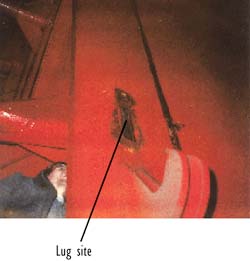
The survey report, when read at the Bureau Veritas regional office in Gothenburg, was not considered to indicate a serious incident. No initiative was therefore taken to investigate the matter further, nor was any general action taken.
 The repaired side locking lug mounting site was surveyed after the ESTONIA accident. The survey showed repair by multiple welding of the cracked lug weld sites, and local backing plates had been added. Some old cracks were also detected. The repaired side locking lug mounting site was surveyed after the ESTONIA accident. The survey showed repair by multiple welding of the cracked lug weld sites, and local backing plates had been added. Some old cracks were also detected.
 The visor mating lug to the bottom lock of DIANA II was also recovered with the bottom locking bolt. The locking bolt had extensive wear on its upper forward sector in a location mating with the eye of the lug that had also worn. The visor mating lug also showed marks from overloading in tension, as its eye had been extended by stretching at the aft tip of the lug. Strengthening plates had been added to the mating lug both to strengthen its tip and to add vertical rigidity to its attachment to the visor structure. It is not known when these reinforcements were installed. The bolt of the bottom lock was made of high-strength steel grade approximately 700 MPa ultimate strength, and the visor mating lug was of mild steel. The visor mating lug to the bottom lock of DIANA II was also recovered with the bottom locking bolt. The locking bolt had extensive wear on its upper forward sector in a location mating with the eye of the lug that had also worn. The visor mating lug also showed marks from overloading in tension, as its eye had been extended by stretching at the aft tip of the lug. Strengthening plates had been added to the mating lug both to strengthen its tip and to add vertical rigidity to its attachment to the visor structure. It is not known when these reinforcements were installed. The bolt of the bottom lock was made of high-strength steel grade approximately 700 MPa ultimate strength, and the visor mating lug was of mild steel.
 The Commission has not been able to verify whether the local office of the Swedish Maritime Administration was informed of the DIANA II incident. From the vessel it is claimed that information was given to the Administration by way of a telephone call one of the first days after the incident, and that the inspector answering the call was satisfied with the way the repairs had been carried out. The Administration on the other hand claims that no information on the incident was received until after the ESTONIA accident. An inspector from the Administration visited the DIANA II about one month after the visor incident. He was called to survey a gangway and claims that at the time of the visit, he had no information on any damage to or repair of the bow visor or its attachments. The Commission has not been able to verify whether the local office of the Swedish Maritime Administration was informed of the DIANA II incident. From the vessel it is claimed that information was given to the Administration by way of a telephone call one of the first days after the incident, and that the inspector answering the call was satisfied with the way the repairs had been carried out. The Administration on the other hand claims that no information on the incident was received until after the ESTONIA accident. An inspector from the Administration visited the DIANA II about one month after the visor incident. He was called to survey a gangway and claims that at the time of the visit, he had no information on any damage to or repair of the bow visor or its attachments. |
 |

